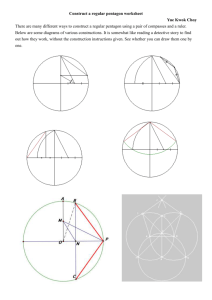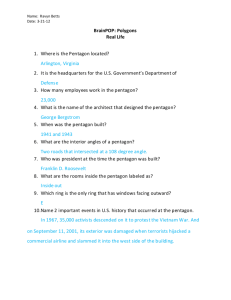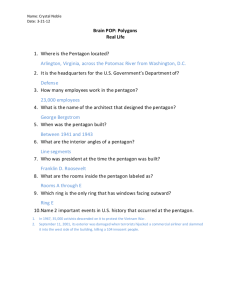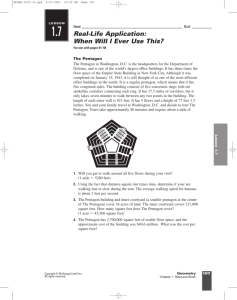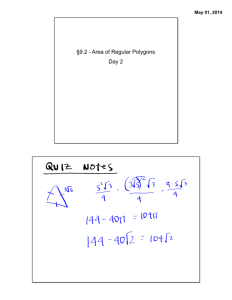returningapolygontoitsoriginalposition_la1
advertisement
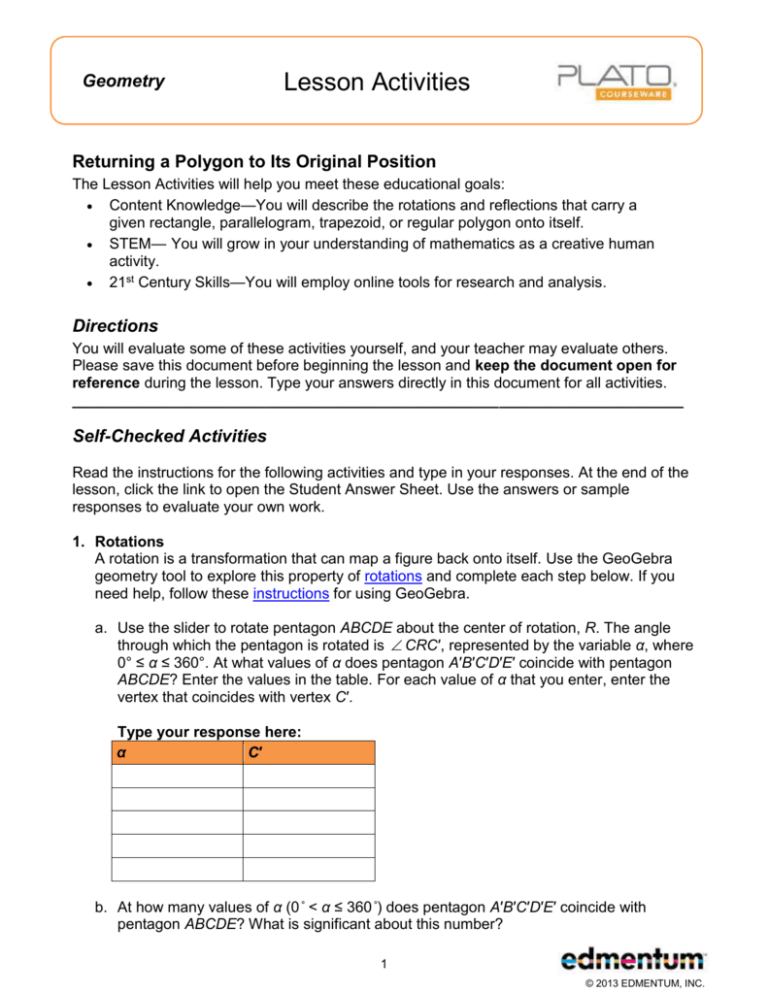
Geometry Lesson Activities Returning a Polygon to Its Original Position The Lesson Activities will help you meet these educational goals: Content Knowledge—You will describe the rotations and reflections that carry a given rectangle, parallelogram, trapezoid, or regular polygon onto itself. STEM— You will grow in your understanding of mathematics as a creative human activity. 21st Century Skills—You will employ online tools for research and analysis. Directions You will evaluate some of these activities yourself, and your teacher may evaluate others. Please save this document before beginning the lesson and keep the document open for reference during the lesson. Type your answers directly in this document for all activities. _________________________________________________________________________ Self-Checked Activities Read the instructions for the following activities and type in your responses. At the end of the lesson, click the link to open the Student Answer Sheet. Use the answers or sample responses to evaluate your own work. 1. Rotations A rotation is a transformation that can map a figure back onto itself. Use the GeoGebra geometry tool to explore this property of rotations and complete each step below. If you need help, follow these instructions for using GeoGebra. a. Use the slider to rotate pentagon ABCDE about the center of rotation, R. The angle through which the pentagon is rotated is CRC′, represented by the variable α, where 0° ≤ α ≤ 360°. At what values of α does pentagon A′B′C′D′E′ coincide with pentagon ABCDE? Enter the values in the table. For each value of α that you enter, enter the vertex that coincides with vertex C′. Type your response here: α C′ b. At how many values of α (0˚ < α ≤ 360˚) does pentagon A′B′C′D′E′ coincide with pentagon ABCDE? What is significant about this number? 1 © 2013 EDMENTUM, INC. Type your response here: c. Now move the center of rotation, R, to a different position on the coordinate plane. Next, move the slider bar to rotate pentagon ABCDE. How many times does the pentagon map back onto itself in this situation? What does this tell you about the location of the center of rotation? Type your response here: d. Move the center of rotation back to the origin (0, 0) of the coordinate plane. Now alter pentagon ABCDE by moving one or more line segments on the pentagon to a different location. Rotate the pentagon using the slider. How many times does the pentagon map back onto itself in this situation? What can you conclude about the kinds of polygons that can map back onto themselves? Describe them. Type your response here: e. List at least three shapes, other than pentagons, in the table. If the shape is a polygon, indicate whether the shape is regular or irregular. Find the number of times that will the shape will map back on to itself as the shape rotates 360°about its center. Also note how many degrees the shape has rotated each time it maps back onto itself. Use GeoGebra to guide you in this exercise, if you wish. Type your response here: Times Mapped Shape onto Itself Degrees Rotated How did you do? Check a box below. Nailed It!—I included all of the same ideas as the model response on the Student Answer Sheet. Halfway There—I included most of the ideas in the model response on the Student Answer Sheet. Not Great—I did not include any of the ideas in the model response on the Student Answer Sheet. 2. Reflections A reflection is a transformation that can map a figure back onto itself. Use GeoGebra to explore this property of reflections and complete each step below. 2 a. Hexagon AGHBGHCGHDGHEGHFGH is a reflected image of hexagon ABCDEF. The midpoints of the sides of hexagon ABCDEF are also shown. Drag the line of reflection, GH , until the image coincides with the preimage. At this location, if the preimage flips about the line of reflection, it will flip onto itself. In how many different positions can you place GH so the image reflects onto the preimage in this manner? Describe the different positions. Be sure to pass the line of reflection through both vertices and midpoints before answering. Type your response here: b. You’ve seen how a polygon can reflect onto itself during a transformation. Use what you know about symmetry to describe the line of reflection required for such a transformation. Be sure to use the word symmetry in your answer. Type your response here: c. List at least three shapes, other than hexagons, in the table. If the shape is a polygon, indicate whether the shape is regular or irregular. Find the number of lines of reflection that will map each shape back on to itself when the shape flips about the reflection line. Also describe the position of the line of reflection in your own words. Use GeoGebra to guide you in this exercise, if you wish. Type your response here: Number of Lines Shape of Reflection Description d. Review your work in parts a through c. What pattern do you observe regarding the number of lines of reflection through a regular polygon that will map the polygon onto itself? How does this number relate to the number of lines of symmetry for the same polygon? Type your response here: e. Some regular polygons have an even number of sides. Other regular polygons have an odd number of sides. How does the number of sides, even or odd, affect the position of the line of reflection for mapping the polygon onto itself? Explain. Use GeoGebra to guide you, if you wish. Type your response here: 3 How did you do? Check a box below. Nailed It!—I included all of the same ideas as the model response on the Student Answer Sheet. Halfway There—I included most of the ideas in the model response on the Student Answer Sheet. Not Great—I did not include any of the ideas in the model response on the Student Answer Sheet. 4
